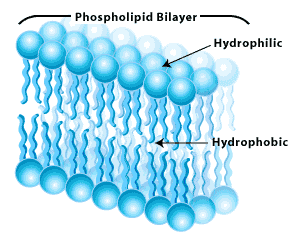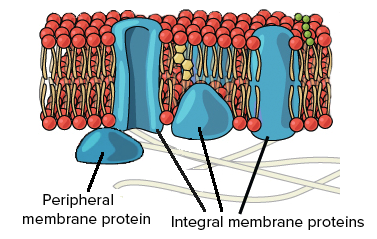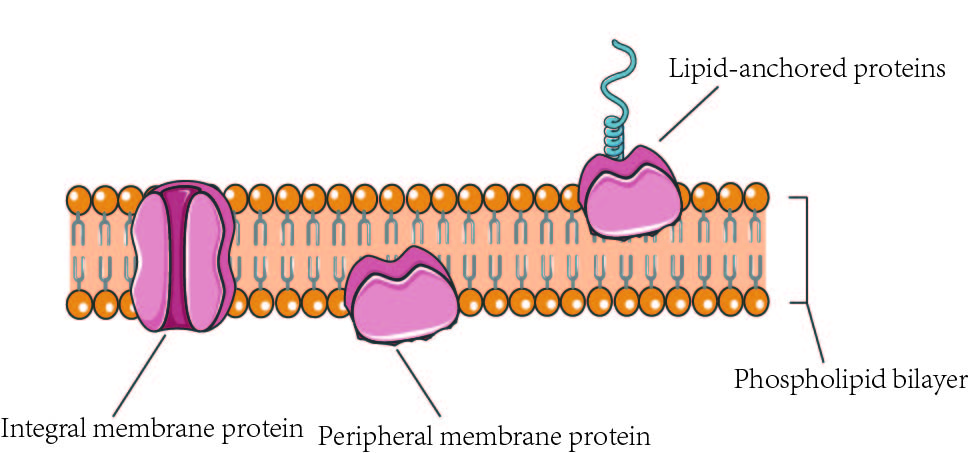CELL BIOLOGY- CELL MEMBRANE
CELL BIOLOGY
(USEFULL FOR NEET, CSIR NET, DBT-JRF, ICMR,BARC,IIT-JAM, M.SC, B.SC
WHAT IS CELL?
Cell is the structural an functional unit of life. what actually mean by structural unit? we all know that every organism starts its life from one single cell, zygote. Zygote go through cell division to generate new cell. gradually frequent and regulated cell division result in cell growth and growth of the enzyme. Cell can be prokaryotic or eukaryotic depending upon there organelle present in the cell. Basically wheather the cell have developed nucleus or not the cell can be of eukaryotic or prokaryotic.
Wheather its a prokaryotic or eukaryotic cell the cell membrane shows similar characteristics. Details are discussed below.
CELL MEMBRANE:
Cell is the
structural and functional unit of life. Cell membrane protects the cell i.e all
internal organelle and the intracellular molecules from the external
environment. Cell membrane also participates in communications and
transportation of biomolecules between intracellular and extracellular
environment.
Cell
membrane shows a typical structure having a lipid bi-layer (thick) and embedded
protein layer according to the ‘Fluid Mosaic Model’ proposed by Singer and
Nicolson in 1972.
CHEMICAL
COMPONENETS OF CELL MEMBRANE:
Lipid-
forms the lipid bilayer of the cell membrane.
Protein-
forms the membrane proteins which are of two types integral protein and
peripheral protein.
Carbohydrate
– carbohydrates are present in the cell membrane in the form of glycolipid
(bound to lipids) and glycoprotein (bound to protein)
LIPID BILAYER:
Lipid molecules constitute the bulk and thick
components of cell membrane, lipid bilayer. There are about 109
lipid molecules in the cell membrane of a single animal cell. All the lipid
molecules in the plasma membrane are amphiphilic
in nature that is they have a hydrophilic
(water loving) or polar end and a hydrophobic
(water fearing) or non polar end.

POLAR
MOLECULES- A polar molecule
is a chemical species in which the distribution of electrons between the
covalently bonded atoms is not even.
Example
– water, ammonia.
NON
POLAR MOLECULES - A molecules make
of electronegatively similar atoms, which distribute electrons equally.
Example-
carbon dioxide, methane.
Three
classes of lip[id molecules are present in the cell membrane- phospholipids,
glycolipids and sterols.
The
most abundant lipid molecule of the cell membrane is the phospholipids.
PHOSPHOLIPIDS- Phospholipids
are composed of one primary alcohol, phosphate group, one secondary alcohol,
two fatty acid chain. Depending upon the primary alcohol phospholipids can be
of two types- glycerophospholipids (glycerol), sphingolipids (sphingosine).
Figure - Phospholipids of cell membrane
The
other important class of phospholipid are sphingolipids. It contains
sphingosine instead of glycerol. In case of sphingomyeline, the most common
sphingolipids, a fatty acid tail is attached to the amino group, and a
phosphocholine group is attached to the terminal hydroxyl group.
At
neutral pH (pH 7), phosphatidylecholine and phosphatidyleethanolamine carry no net
electric charge, whereas phosphatidyleionositol
and phosphatidyleserine carry a
net negative electric charge.
MEMBRANE ASYMMETRY OF LIPIDS:
The
lipid composition is different in the cytosolic leaflet and non-cytosolic or
exoplasmic leaflet of the phospholipid bilayer. In plasma membrane of human
erythrocyte cells sphingomyeline and phosphatidylecholine found more in number
in the exoplasmic side of phospholipid bilayer, whereas phosphatidyleserine,
phosphatidyleethanolamine and phosphatidyleionositol are preferentially located
in the cytosolic side of the phospholipid bilayer. Although these phospholipids
molecules are generated in the ER they oriented in preferential manner in the
phospholipid bilayer with the involvement of three enzymes flippase, floppase and scramblase. After synthesis phospholipid
molecules are equally distributed in two phospholipid monolayers, and this is
mediated by scramblase, a phospholipid translocator protein.
Thereafter flippase, a P-type active
transporter protein transport phospholipids (phosphatidyleserine,
phosphatidyleethanolamine, phosphatidyleionositol) from outside to inside. On the other hand another floppase, another active transporter protein transport phospholipid
molecules (phosphatidylecholine, sphingolipids) from inside to outside. Scramblase is a ATP independent
transporter protein.
FLIPPASE
|
FLOPPASE
|
SCRAMBLASE
|
P-type
|
ABC
type
|
|
ATP
dependent
|
ATP
dependent
|
ATP
independent
|
Outside
to inside
|
Inside
to outside
|
Both
direction and lateral direction
|
However
there is a significant differences is available in lipid asymmetry between apoptotic
or cancer cell and normal cell. In apoptotic cell or cancer cell phosphatidylecholine
found more in cytosolic end and phosphatidyleserine found more in exoplasmic
cell. This is a very useful difference between cancer cell and normal cell.
MEMBRANE FLUIDITY: Cell
membrane has a quasi-fluid structure. Cell membrane maintains a critical
fluidity so as to maintain its semi-permeability. Fluidity is essential to
transport gasses, nutrients, signalling molecules, and also for movement of
phospholipids molecule along the membrane plane. For example human live in
different climatic region. But there a lot of differences between cell membrane
compositions among people live in colder region and temperate region. The cell
membrane fluidity is controlled by various factors,
1)
Temperature:
As
the temperature increases the fluidity of the membrane increases. Increasing in
temperature increase the kinetic energy of phospholipids molecules and also
decrease the interaction between lipid molecules thus increase the fluidity.
Decrease in temperature in turn decrease the membrane fluidity and make the
cell membrane more rigid in nature. The temperature at which membrane behaves
like 50% fluid and 50% gel like structure is known as transition melting point (Tm).
2)
Fatty
Acid Chain Length: Long saturated fatty acid chains have
more tendency to aggregate and packed tightly by van der walls interaction and
hydrophobic interactions, thus make the membrane more gel like state or
increase the rigidity and decrease the membrane fluidity. Meanwhile presence of
short fatty acid chains increase the membrane fluidity as there is less surface
area available for van der walls interaction and hydrophobic interaction.
3)
Degree
of Saturation: Phospholipids with unsaturated fatty
acid chains that is fatty acid chains having double bond or triple bond
structure, increase the membrane fluidity. Unsaturation that is presence of
double bond structure in the fatty acid chain form kink structure and increase
the distance between adjacent fatty acid chains of neighbouring phospholipid
molecules. This in turn reduces the tendency to interact with other
phospholipid molecules. So more the unsaturation more will be the membrane
fluidity.
Sterol: There is another molecule sterol, is
also responsible for maintaining the cell membrane fluidity. Sterols are lipid
soluble molecules and these are amphipathic in nature. These are mainly
responsible for maintaining of membrane rigidity. In case of animal cell the
sterol present is known as cholesterol, in
case of plant the sterol present is known as phytosterol. Most common phytosterol are brassicasterol, campesterol, sitosterol, stigmasterol, avenasterol. In
case of fungi the sterol present is known as ergosterol. Bacteria contain hopanoids
instead of sterol. In animal cells Cholesterols mainly interact with phospholipids present in the cell membrane. Cholesterol
present in between lipid molecules and interacts with phospholipids by the
means of hydrophilic interaction and hydrophobic interaction as cholesterol
shows amphipathic character. Basically in cold temperature cholesterol concentration
increases so as to prevent possibilities to be more rigid as it prevent
phospholipid molecules to came more closer. Whereas in high temperature
cholesterol also prevent lipid molecules from being separated out from each
other by means of hydrophobic interaction with fatty acid chains. So the main
role of cholesterol in the plasma membrane to maintain membrane fluidity.
MEMBRANE PROTEINS:
As
we know cell membrane is composed mainly of lipids and proteins. Protein
molecules are embedded in the phospholipid bilayer. Membrane proteins play a
major role in maintaining the functions of a specific cell. Membrane proteins
are amphipathic in nature. Membrane proteins can be classified as
1) Integral protein
2)
Peripheral protein
3) Lipid anchor protein
 |
| Arrangement of various membrane protein |
1) Integral Protein: Integral
proteins also called trans membrane protein. These type of protein shows three
part cytosolic domain, exoplasmic domain
and transmembrane domain. The cytosolic and exoplasmic domain have
hydrophilic surface which interact with the aqueous of the cytosolic and
exoplasmic environment. The transmembrane domain or the membrane spanning
segment of the protein is hydrophobic in nature and it interacts with the fatty
acid chain of the phospholipid molecules. In all transmembrane proteins
examined till date, the membrane spanning domains consists of one or more
α-helix or of multiple β-strands. Glycophorin, BAND-3, GPCR, Aquaporin, Ion
channels, ATP Binding Cassette, Human Leukocyte Antigen (HLA), are some example
of transmembrane protein.

Depending
upon the number of time a transmembrane protein pass the lipid bilayer TM
protein may be single pass (monotopic) or multi-pass (polytopic). Glycophorin,
the major protein the human erythrocyte cell membrane, is a representative
single pass transmembrane protein, which contains only one single membrane
spanning α-helix. It is composed of 131 amino acid residues. BAND-3 is a
multi-pass TM protein which contains 929 amino acid residues and 14
transmembrane segment. The aquaporins are a large family of highly conserved
which transport water, glycerol and other hydrophilic molecule across the cell
membrane. Aquaporins have 6 membrane spanning α-helix. Porin a class of
transmembrane protein have β-barrel strand in transmembrane segment. Porins are
present in outer membrane of gram-negative bacteria like E.coli.

2.Peripheral Protein:
Peripheral proteins do not directly
contact the hydrophobic core of the phospholipid bilayer. Instead they are
bound to the membrane either indirectly by interactions with integral or lipid
anchored membrane proteins can be bound
to either the cytosolic or the exoplasmic face of the plasma membrane.
Peripheral proteins covalently attached to the cell membrane. Spectrin,
anchyrin, BAND-4.1 are well known example of peripheral proteins.
3.Lipid Anchor Protein:
Lipid anchor proteins are covalently
bounded to one or more lipid molecules. The hydrophobic segment of the attached
lipid is embedded in one leaflet of the membrane and anchor the proteins to the
membrane. The polypeptide chain itself does not enter the phospholipid bilayer.
GPI- anchor protein is a type of lipid anchor protein.

FOR MORE DETAIL FOLLOW THIS BOOKS
1. MOLECULAR BIOLOGY OF THE CELL-
2. LODISH CELL BIOLOGY:
VARIOUS STUDY MATERIALS FOR NEET, NET, DBT etc.



















Wow!! This give me a clear and complete concept of cell membrane.... Please sir write about cel cycle....
ReplyDeleteThanks for your response. keep following my blog. I will definitely write about cell cycle.
ReplyDelete